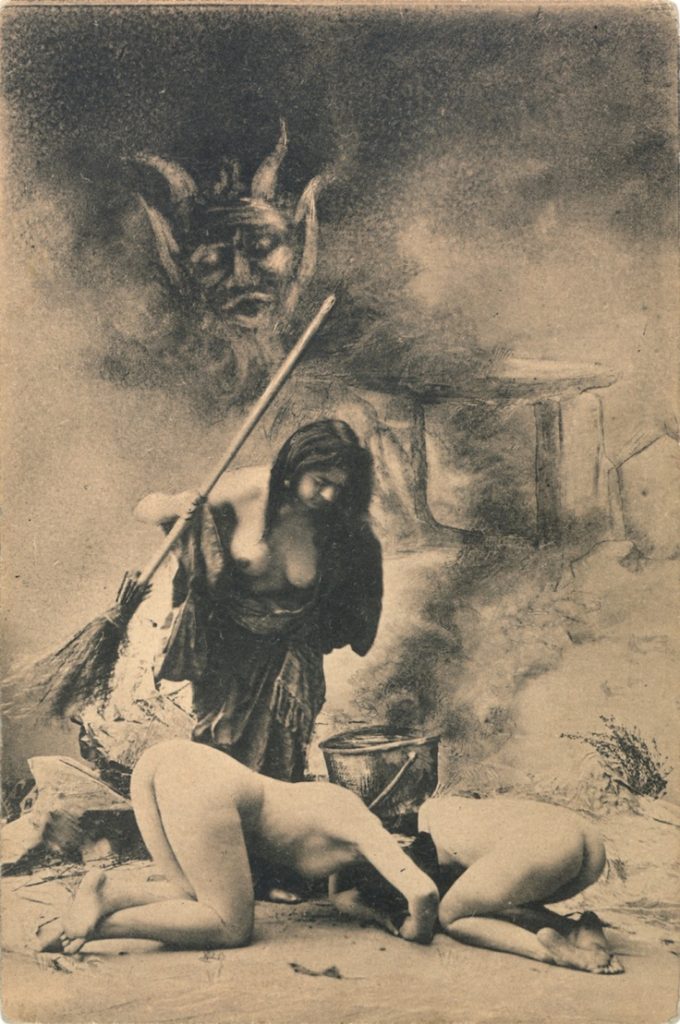IN THE EARLY SEVENTEENTH CENTURY, renowned dramatist, poet and favorite of the royal court composed a series of masques for the court’s entertainment. A masque consisted of music, dance and acting, performed in a private setting featuring elaborate costumes, professional actors and elaborate stage design. The stage and costumes were often designed by renowned architects, in this case it was Inigo Jones.
For the Masque of Queens, Johnson drew heavily upon King James’ Daemonologie, which spoke of the practices, identification and prosecution of witches. Much of what we believe, what we have come to think of when we hear the word witch draws from this source, which influenced others who have reinforced the stereotypes, such as the witches of Macbeth in Shakespeare’s play.
The idea that witches danced in their rituals didn’t exist in England at the time. It was a Scottish and continental notion, which King James, who came from a a Scottish family, brought to England with the publication of the Daemonologie .
The English tradition had witches being solitary figures, shunning the society of others. With the Daemonologie, the coven became a part of the lore that influenced not only the idea of witches in literature and the arts, but in practice as well.
In Johnson’s play, the leader of the witches is described as “naked armed, barefooted, her frock tucked, her hair knotted and folded with vipers; in her hand a torch made of a dead man’s arm, lighted; girded with a snake.”
Today when we read sixteenth century verse, we tend to forget these pieces were often performed. In this instance, the case could be made that this is the song that taught witches to dance.
The Witches’ Song, from Masque of Queens
Ben Johnson (1572-1637)
1 WITCH.
“I HAVE been all day looking after
A raven feeding upon a quarter:
And, soone as she turn’d her beak to the south,
I snatch’d this morsell out of her mouth.”
2 WITCH.
“I have beene gathering wolves haires,
The madd dogges foames, and adders eares;
The spurging of a dead man’s eyes:
And all since the evening starre did rise.”
3 WITCH.
“I last night lay all alone
O’ the ground, to heare the mandrake grone;
And pluckt him up, though he grew full low:
And, as I had done, the cocke did crow.”
4 WITCH.
“And I ha’ beene chusing out this scull
From charnell houses that were full;
From private grots, and publike pits:
And frighted a sexton out of his wits.”
5 WITCH.
“Under a cradle I did crepe
By day; and, when the childe was a-sleepe
At night, I suck’d the breath; and rose,
And pluck’d the nodding nurse by the nose.
6 WITCH.
“I had a dagger: what did I with that?
Killed an infant to have his fat.
A piper it got at a church-ale.
I bade him again blow wind i’ the taile.”
7 WITCH.
“A murderer yonder was hung in chaines;
The sunne and the wind had shrunke his veins:
I bit off a sinew; I clipp’d his haire;
I brought off his ragges, that danc’d i’ the ayre.”
8 WITCH.
“The scrich-owles egges and the feathers blacke,
The bloud of the frogge, and the bone in his backe
I have been getting; and made of his skin
A purset, to keepe Sir Cranion in.”
9 WITCH.
“And I ha’ beene plucking (plants among)
Hemlock, henbane, adders-tongue,
Night-shade, moone-wort, libbards-bane;
And twise by the dogges was like to be tane.”
10 WITCH.
“I from the jaw’s of a gardiner’s bitch
Did snatch these bones, and then leap’d the ditch:
Yet went I back to the house againe,
Kill’d the blacke cat, and here is the braine.”
11 WITCH.
“I went to the toad, breedes under the wall,
I charmed him out, and he came at my call;
I scratch’d out the eyes of the owle before;
I tore the batts wing: what would you have more?”
DAME.
“Yes: I have brought, to helpe your vows,
Horned poppie, cypresse boughes,
The fig-tree wild, that grows on tombes,
And juice, that from the larch-tree comes,
The basiliskes bloud, and the vipers skin:–
And now our orgies let’s begin.”

